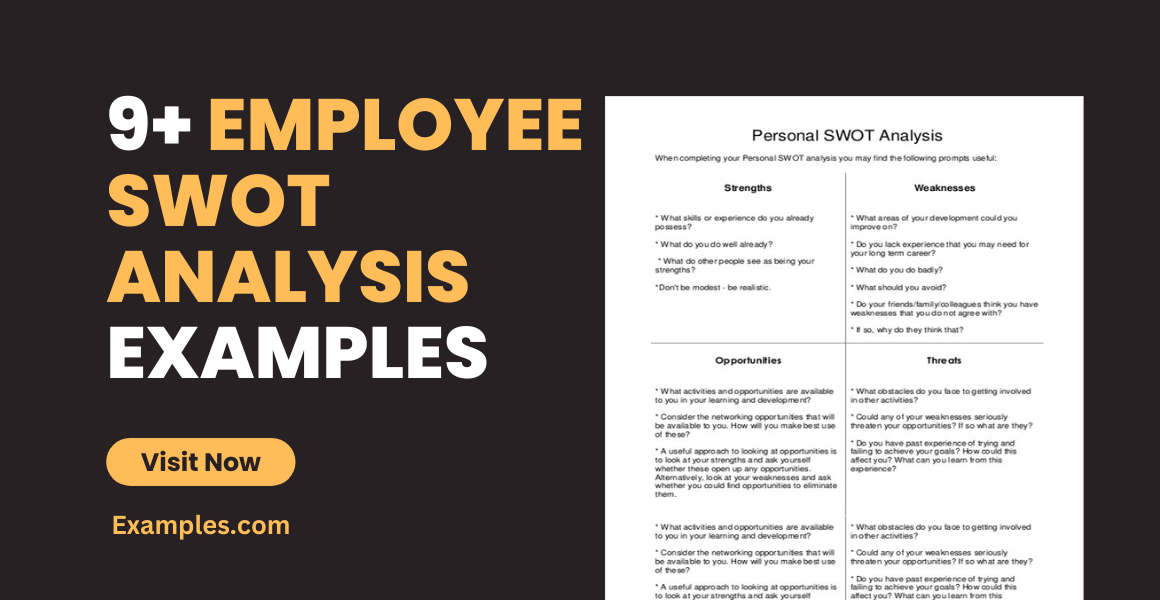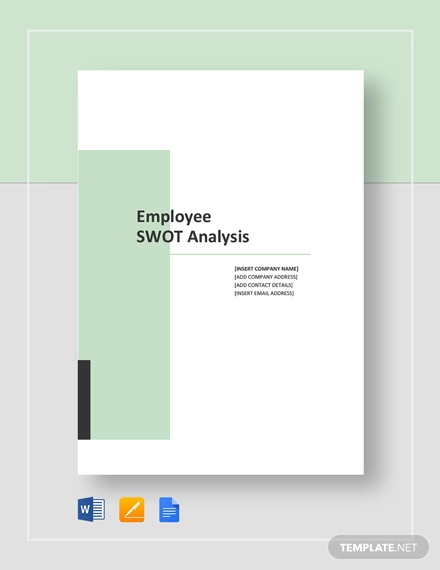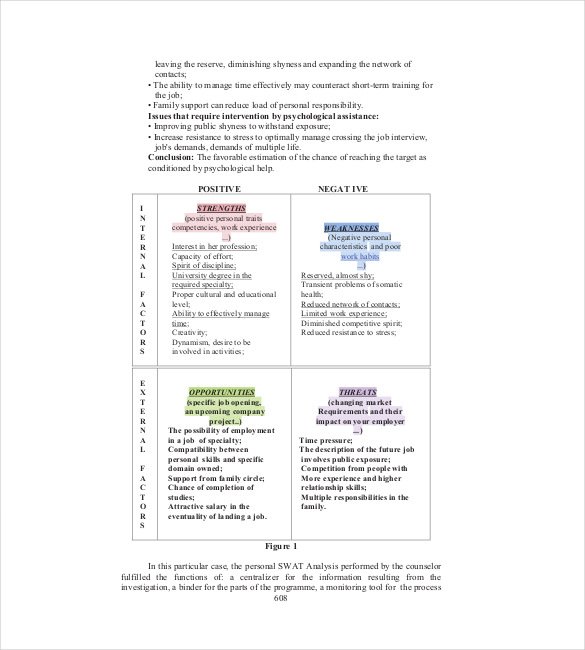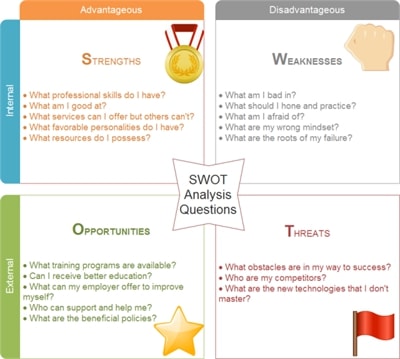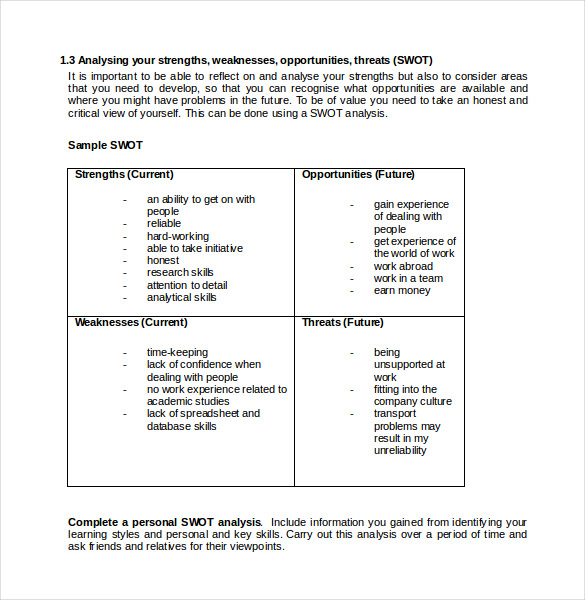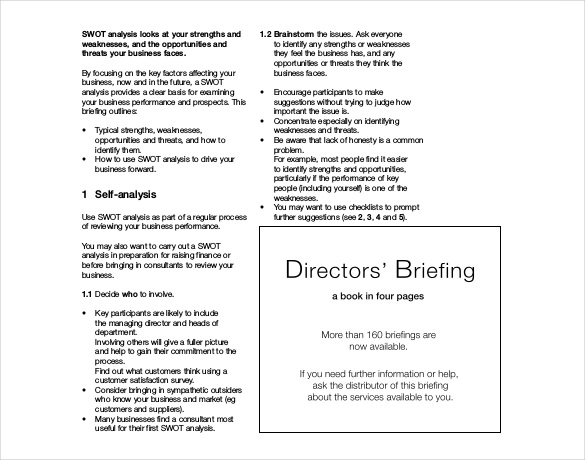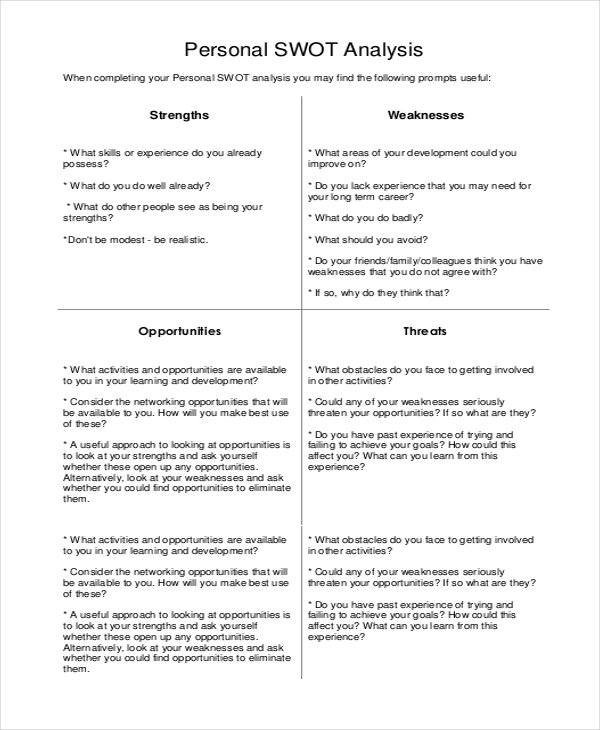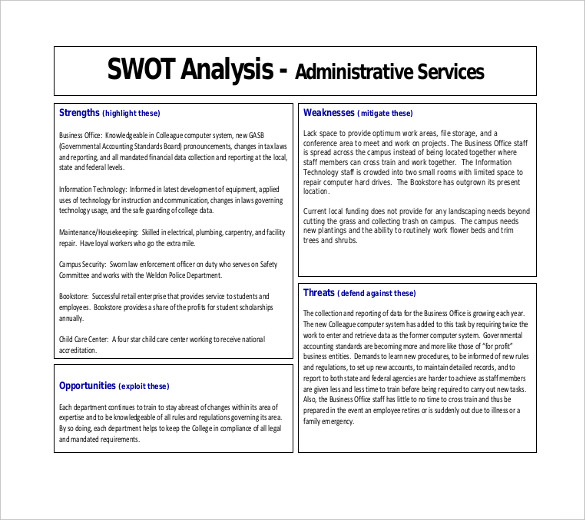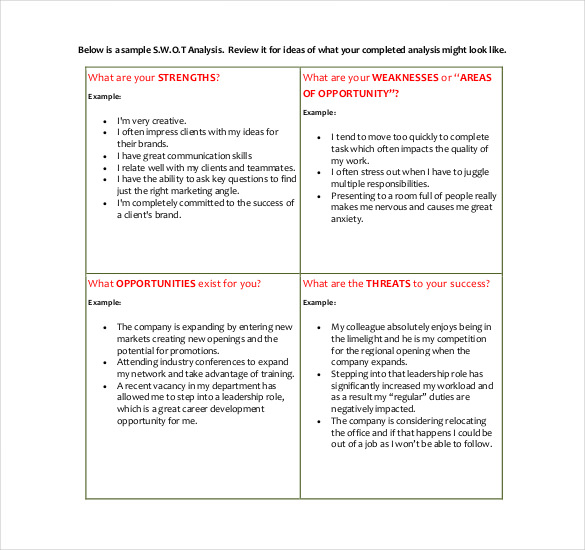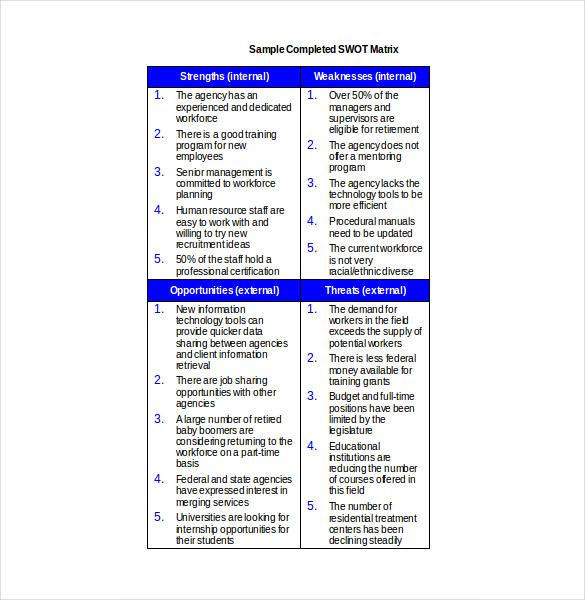9+ Employee SWOT Analysis Examples to Download
SWOT analysis is important for any business. Although this type of analysis is helpful for businesses or companies in general, it is also helpful for employees in particular. The great thing about SWOT analysis is that it studies both internal and external factors, making it a very effective business tool.
To help you create an effective SWOT analysis, we have provided some examples that can help you formulate your own employee SWOT analysis.
Sample Employee SWOT Analysis Template
Sample Employee SWOT Analysis Template
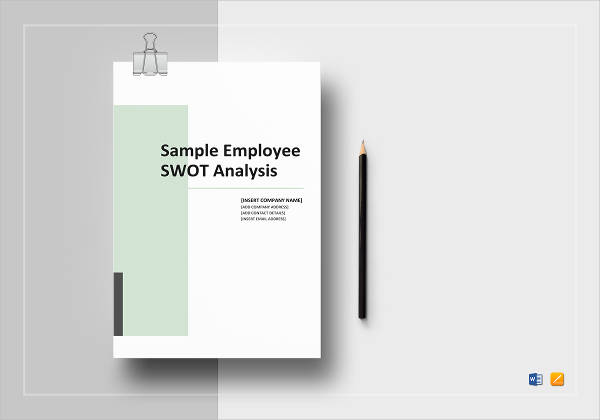
Detailed Employee SWOT Analysis Example
New Employee SWOT Analysis Example
The Importance of SWOT Analysis
The SWOT in SWOT analysis stands for strengths, weaknesses, opportunities, and threats. As previously mentioned, SWOT analyzes both the internal and external environment of a business organization. Strengths and weaknesses focus on the internal environment while opportunities and threats focus on the external environment. You may also see SWOT analysis worksheet examples.
The reason why strengths and weaknesses are used for the internal environment is that a company cannot control the external environment, and although the external environment cannot be fully controlled, it can nonetheless provide opportunities and threats. You may also like personal SWOT analysis examples.
When done correctly, detailed SWOT analysis is very helpful as it provided a very detailed and comprehensive analysis. SWOT analysis is a tried and tested strategic tool used not only by large corporations but also public institutions such as schools or universities, government offices or bureaus, and hospitals, to name a few.
Every company, even the largest (i.e., Microsoft, Google, Amazon, etc.), has a finite supply of manpower, production capacity, and capital. Finding and evaluating the company’s strengths helps it determine how to allocate these resources that will result in the highest possible potential for profitability and sustainability. You may also check out hospital SWOT analysis examples.
When the management team looks at the company’s weaknesses, it is not to blame people in the company (or who have worked for the company) for past mistakes.
Identifying weaknesses specifically deals with fixing critical areas that need to be improved in order for the business to operate on a daily basis. A general assessment of weaknesses also prevents problems such as the business entering the market with products that are clearly inferior to what other companies are currently selling.
Growth in business requires finding new opportunities (these opportunities include new customer groups, broader product distribution, developing new categories of products and services, geographic expansion, etc.).
In SWOT analysis, the management team (or individuals creating the analysis) identifies opportunities that they can take advantage of in the future while also forecasting long-term opportunities through formulating long-term planning. If the forecast is right, they will be more prepared to enter the market. You might be interested in marketing SWOT analysis examples.
In regards to threats, business organizations face threats that are mostly caused by direct competitors. Changes in the regulatory environment can also have an adverse impact on performance. A threat in SWOT analysis is also classified as risk—a situation that occurs outside the company’s control which certainly has a negative impact on performance. You may also see manager SWOT analysis examples.
Employee Personal Skills SWOT Analysis Example
Sample Employee SWOT Analysis Example
Personal Employee SWOT Analysis Example
Tips in Creating an Employee SWOT Analysis
SWOT analysis is not meant to be simply conducted by organizations and corporations alone. SWOT analysis can be conducted by individuals as well, in this case an employee SWOT analysis. Listed below are some essential tips in creating an employee SWOT analysis. Don’t forget to check our personal SWOT analysis so that you can be easily guided.
1. Determine the objective
The first tip in creating an employee SWOT analysis is to determine the objective in creating the said analysis. You are not only creating a SWOT analysis just for the sake of it. The objective also acts as the goal on what you want to achieve after conducting the general analysis. Since you are creating an employee SWOT analysis, your objectives would likely center around becoming a more efficient and productive employee.
Listing down objectives helps you create a road map or blueprint for the SWOT analysis. These objectives should not be lengthy, but short and concise similar to a company vision statement and mission statement. Listed below are some objective samples:
- This SWOT analysis aims to identify issues regarding the employee’s productivity and create solutions to fix them.
- The end-goal of this SWOT analysis is to find long-term solutions in regards to the employee’s ongoing tardiness issues.
2. Create a grid or matrix
A SWOT analysis always follows a standard format: grid or matrix. This aids in the easier writing or inputting of items listed in the SWOT analysis. Since the items are all placed in a box-like figure, there is definitely no need to write long sentences or paragraphs, just bullet-form phrases. Explanation for each item in the SWOT analysis can be done later, in which there is no limit on the length of the explanation or discussion. You may also see internal audit SWOT analysis examples.
3. Draw conclusions
Identifying problems in a SWOT analysis is not enough, you need to solve it. That is the reason why conclusions are very important in a SWOT analysis. Conclusions are basically the solutions that result from identifying problems in the said simple analysis. Conclusions can also be called “recommendations” in other business studies.
Listed below are sample conclusions for an employee SWOT analysis:
- The employee will undergo a two-week review training program to improve his daily work responsibilities which include creating quarterly tax returns and monthly income statements.
- The employee will meet with his immediate supervisor once a week for the next three weeks to discuss work-related issues that need to be fixed as soon as possible.
Template for Employee SWOT Analysis Example
Printable Employee SWOT Analysis Example
Simple Employee SWOT Analysis Example
Sample Employee SWOT Analysis Outline
We created a sample employee SWOT analysis that can serve as a reference when you will be creating your own SWOT analysis. An employee SWOT analysis can be created from two perspectives: perspective of the employer/immediate supervisor or perspective from the employee himself (self-assessment). This employee SWOT analysis is written from the vantage point of the employer. You may also see how to prepare SWOT analysis for business.
This SWOT analysis has been created to discuss the performance of Employee A in his one year of working in this company. The basic analysis mainly aims to identify areas that he needs to improve for better productivity and efficiency.
1. Strengths
- Employee A manages to complete his tasks on time, and during his one-year stint with the company, he only failed to complete his tasks on set deadline date/time a few times.
- According to his immediate supervisor, Employee A is one of the most productive members of his team, and has consistently been meeting the monthly required quota since he joined the company over a year ago. You may also like hotel SWOT analysis examples.
- Employee A manages to get along well with this colleagues, not only with members of his team but also with other employees in other teams and departments.
2. Weaknesses
- Employee A occasionally disturbs his colleagues when they are in the middle of their respective work tasks and responsibilities, in which Employee A has been reprimanded by his manager a few times already.
- Employee A also has the tendency to brag about his achievements in the workplace. The company preaches humility for all of its employees and should be a value that should be observed in the workplace at all times. You may also check out retail SWOT analysis examples.
3. Opportunities
- Due to his consistent work performance, Employee A is up for promotion. The promotion will still be discussed with his immediate supervisor and with other top-level officers in the company in the next few weeks. You might be interested in restaurant SWOT analysis examples.
- Employee A will also be given additional work responsibilities which will help him in his future promotion.
- A new department will open within the company in the next month, in which Employee A might be assigned to.
4. Threats
- Employee A’s performance has not gone unnoticed by other companies. He might be snapped by other employers and will be offered higher salary as well as more relaxed working conditions. You may also see SWOT analysis of college examples.
- The national government is planning to increase income taxes by 5% by the next year. It might pose a problem for not only Employee A but for the rest of the employees in the company. You may also like competitor SWOT analysis examples.
- Employee A is reliant on his colleagues for inspiration and motivation. If a few of them resign in the next few months, he might follow suit as well.
We hope you found this article to be informative as well as helpful when you will be creating your own employee SWOT analysis. We also provided some free to download examples that you can use as reference when you will be creating your professional SWOT analysis.
As previously mentioned, SWOT analysis is important for any business. Although this type of analysis is helpful for businesses or companies in general, it is also helpful for employees.


